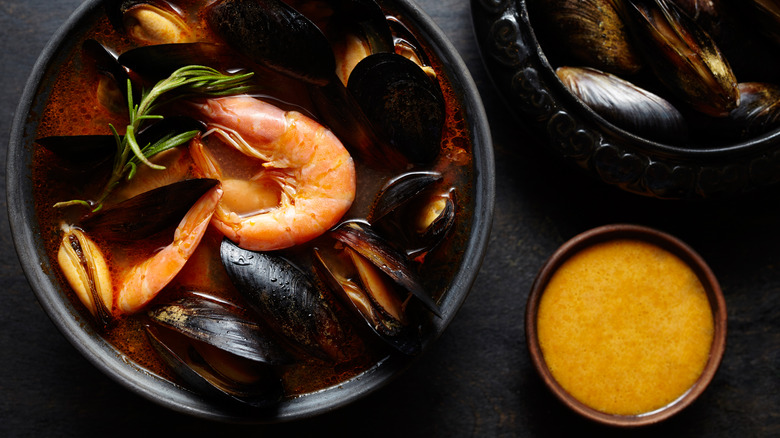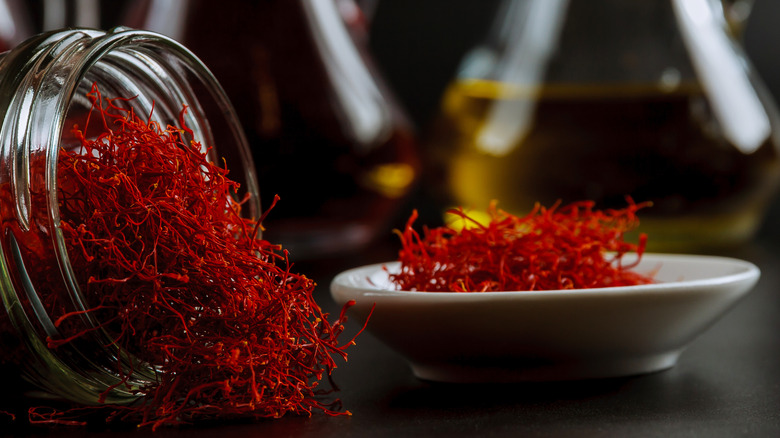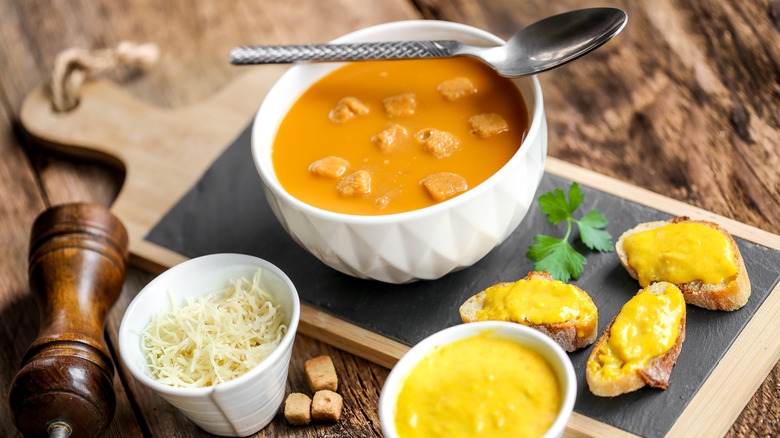What Is Rouille, And How Is It Different From Aioli?
We may receive a commission on purchases made from links.
Aioli and rouille are two of the most famous sauces to come from Provence. Like mayonnaise, both are examples of an emulsion, which is what you get when two usually unmixable ingredients, such as oil and vinegar, are combined. And both are full-flavored thanks to plenty of raw garlic and good olive oil in the mix. But that's where the similarities pretty much end, as the two sauces are made with different ingredients, giving them a unique appearance and taste that can be enjoyed with different sorts of dishes.
Aioli gets its name from the French 'ail,' meaning garlic, and 'oli,' the Provencal dialect for oil. And in its most basic preparation, it contains just those two ingredients pounded together — though it is also commonly made with egg yolks, making it more like a tasty garlicky mayo. The result is a white or pale yellow sauce with a thick, creamy consistency.
Rouille, on the other hand, takes its name from the word for rust. So unsurprisingly, it has a very different appearance, with a rich red-brown color thanks to the inclusion of ingredients such as chili and saffron. And its longer list of additional ingredients and processes is another thing that sets it apart from its Provencal cousin aioli.
Rouille is rust-colored, spicy, and made differently than aioli
While you can make a classic aioli by pounding or blending just a handful of ingredients — you can even transform store-bought mayo into aioli with just two ingredients, garlic and lemon — preparing rouille is a little more complex and time-consuming. As well as egg yolks, olive oil, and garlic, the rich sauce is usually thickened with bread, or sometimes potato pulp. It can even contain pounded liver in some traditional recipes; the French cookery book "Larousse Gastronomique" suggests either scorpion-fish liver or chicken liver as well as strained broth. It's a far cry from garlic mayo, that's for sure.
But in many of the more commonly seen recipes these days (which lose the liver), it's the spices and seasonings that give rouille its signature color as well as much of its flavor. The notoriously expensive saffron plays a large part while some recipes also incorporate fresh chili or chili powder, hot or mild smoked paprika, or even feisty harissa alongside roasted red bell pepper, with fresh lemon juice serving to brighten the peppery flavors. Whichever of the punchy ingredients are used, it makes for a heady combination of spicy and smoky flavors that extend way beyond the simple garlicky hit of cool, creamy aioli.
Rouille and aioli can be used in different ways
Rouille and aioli do share one style of serving in common; they both go beautifully with fish soups. Aioli is often served with the Provencal fish stew bourride while rouille generally accompanies the seafood stew, bouillabaisse.
With aioli, the garlicky sauce is combined with a little of the cooking liquid from the bourride before being mixed back into it to add incredible depth of flavor and texture. Rouille can also be stirred into bouillabaisse to enrich it — though you may also find it served spread on toasted bread to accompany the soup, or even served as two courses; incidentally, its complexity and lengthy cooking makes bouillabaisse one dish that Ina Garten never serves at dinner parties.
But soups aside, aioli and rouille can also be served in quite different ways. Rouille is a traditional accompaniment for fish and seafood — whether that's boiled fish or octopus, crispy fried fish, or firm grilled fish such as Pacific white sea bass or swordfish. Not so traditionally, you could certainly use it to level up grilled cheese, too.
Aioli, meanwhile, can be used as a dip for raw or cooked vegetables, salads, cold meats, hard-boiled eggs, or even french fries. Or go for the Provencal-style 'grand aioli' that sees a platter of meat, fish, vegetables, and bread served as a grazing board, with the garlicky dip as the centerpiece; it's an easy, yet elegant, way to feed a crowd.



